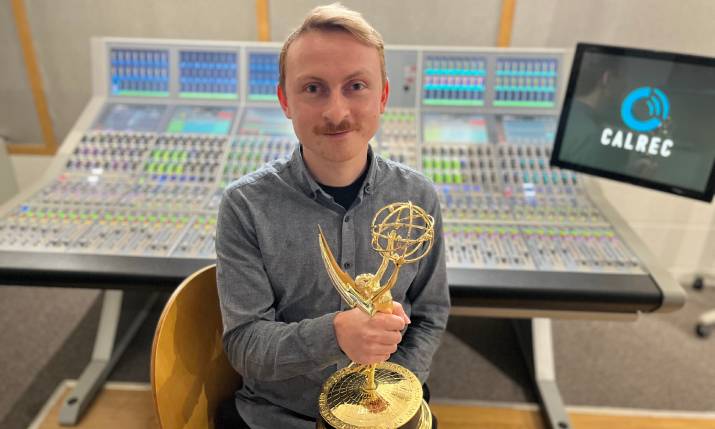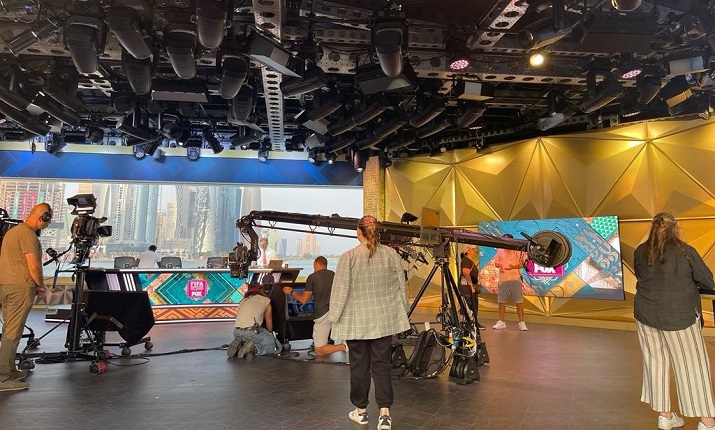Audio engineer Elliot Roberts on winning a Sports Emmy Award for Fox Sports’ presentation of the FIFA World Cup Qatar 2022

Elliot Roberts with his Emmy Award
By Elliot Roberts, Calrec customer support engineer and audio engineer
It’s not every day one wakes up to find the technical team with which you worked to support Fox Sports’ coverage of the FIFA World Cup has won an Emmy! To say it took me by surprise is an understatement, but given the effort involved and the seamless output, it was a just reward for all involved.
For 60 years and counting, Calrec has developed an enviable reputation for its pioneering work across broadcast audio consoles and networking technologies. This allows our customers to benefit from cutting edge technologies at each point in the production chain. Nowhere is this clearer than our renowned understanding of, and work across, the evolution and deployment of IP solutions as the industry now takes advantage of this paradigm shift in what’s possible.
Equally as crucial – and this is a subject area that doesn’t gain the headlines it often deserves – is the sophisticated support structure we have in place to ensure technology installation and integration, however complex, are handled as elegantly and efficiently as possible. The support we provide to our customers is fundamental to the ethos of Calrec.
End to end understanding
This begs a question: What did I, as a key part of the audio engineering team, do to ensure Fox Sport’s coverage of the world’s greatest sporting event engaged viewers as it should and was a seamless experience?
Like many audio engineers, I used to be a musician and always enjoyed the technical side of things. I completed my BSc in Music Technology and Audio Systems at The University of Huddersfield and, fairly shortly after, began my career at Calrec. I have worked my way up to the position of customer support engineer. Each role I have had has increased my understanding and I’ve developed strong audio over IP (AoIP) knowledge as part of this process.
In my current role, I often provide support during installation and during the initial on-air phase. Given Calrec’s key positioning across audio network architectures, I need to have an end to end understanding of each installation and the relationship between all the technologies and suppliers involved. Nowhere is this more important than when it comes to supporting the temporary, complex infrastructure required to bring major sporting events to air.
In this instance, and is now more often than not the case, this was a 2110 set up and, at this scale, was a first for some of those involved. Fox Sports has been rightly widely lauded for the spectacular studio set up it developed and installed in Doha for this tournament.
But there were challenges behind the scenes and a lot of work was involved. This was inevitable as this was an entirely new IP onsite installation. This meant there was a great deal of onsite testing to be carried out and problems that needed to be addressed quickly. There were multiple companies with which we interfaced, though it was mainly with EVS, which had a central role, and Riedel.
We supplied two, IP multi-console systems with a Calrec ImPulse supporting each set up. At the International Broadcasting Centre (IBC), there were three Artemis Beam surfaces, two with Artemis physical controls and one virtual. The IBC was based at the Qatar National Convention Centre and was where I spent the majority of my time.
We installed a very similar setup at the Fox Sports’ state of the art studio located along the Corniche waterfront promenade in Doha. The studio was very impressive with its four stages. This, as mentioned, was a fully IP workflow driven via NMOS with the host broadcaster also supplying all feeds via IP.
I arrived two weeks prior to the on-air date and then stayed five days into the broadcasts. My role was supposed to be pre-configuration work and on-air support, but given the complexity and the deadline, it turned out to be significantly more than I first thought.

Fox Sports crew hard at work at the FIFA World Cup Qatar 2022
Scale and complexity
Because this was an entirely new system, certain elements were still being tested and configured onsite, which has not been unusual as the industry adapts to IP, there was a lot of testing involved and problem solving. As mentioned, while this wasn’t the first time working with IP technologies and workflows for most people there, at this scale and complexity it was for quite a few.
In a more normal install, the audio guarantors would have handled technology configuration to ensure correct working but, because of the aforementioned complexity, and given my experience and the Calrec support infrastructure behind me, it was essential I became involved.
While it may surprise some, there’s still a tendency to prioritise video over audio and, to a certain extent, that was the case here. Central to my role was to make sure I was being heard and that, if not, there were going to be significant issues with the audio. People listened and ultimately understood the essential nature of what was required. We had to carry out a significant amount of troubleshooting.
The level of collaboration was very high, from our perspective in particular with Riedel and EVS. I think IP rollouts have made companies more open in what they’re doing to ensure the end goal is achieved via the necessary level of integration. We all had to accept, given the timescales, some solutions were temporary or only relevant to this installation. By the nature of it, this is a unique ecosystem. Each installation of this nature will have its specifics.
There are additional benefits beyond the fact that we achieved the main goal: flawless, high quality audio across the tournament that satisfied the huge audiences. Working with EVS, we learnt how our systems really work with each other. For example, there are quite a lot of installs that use the company’s Cerebrum NMOS controller, and via this project, we now have a far greater understanding of how Calrec’s technology integrates with it. This works both ways.
This knowledge is invaluable. What’s also important is having an open dialogue with the broadcaster as much as possible in the build-up to an event. The earlier this process begins, and the tighter it is, the better. The understanding we developed on this project has already borne fruit with the re-use of the fundamental components of this setup at sports events that followed.
I – and of course Calrec – are really proud to be part of this award-winning team and we’re very grateful this has been recognised. Now to clear a space in the Calrec trophy cabinet…

